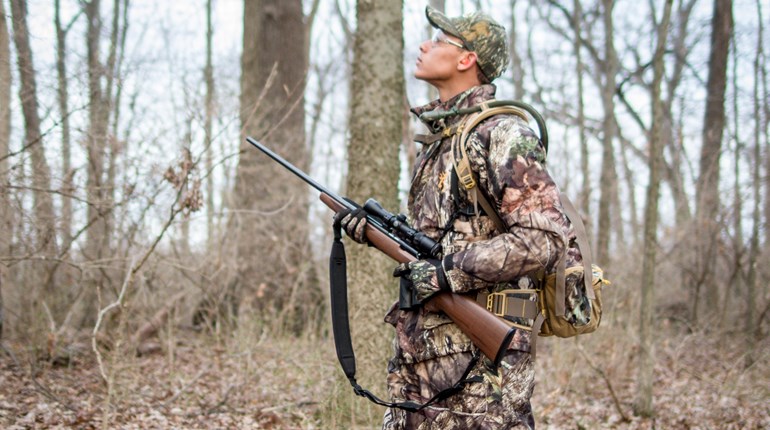
The most painful lesson from last season was likely the most valuable, as they always are. I had two very nice bucks get away because they “jumped the string.” In other words, they dropped at the sound of the shot to load up their legs before leaping away, thus unknowingly eluding the arrow. While not a new phenomenon, this was not something I was used to when hunting in the Midwest; however, the more people I talked to about it, the more I realized this is a major problem for many bowhunters.
I’ve had more does than bucks drop at the sound of the shot. I thought that a relaxed buck would rarely drop at the shot and that even alert bucks only dropped occasionally. Well, that was my old opinion and it has since been shattered by the events of last season.
Success or failure often boils down to one quick decision: What are you going to do with an alert buck? I ran into this tough spot with two bucks that were walking past my stands last season, a common event during the rut. Both bucks were 30 yards away. I drew my bow and then stopped them with a mouth grunt. Both bucks locked up, presenting the nice still, broadside shot I sought. At the shot, they dropped as if a trapdoor had opened beneath them.
The first escapee was bad enough, but when the second one got away three weeks later, I was heartbroken. I have grappled with this dilemma ever since. Should I try to shoot them walking at that distance? A 30-yard walking shot is certainly no slam-dunk. Where should I aim if I stop them? After rolling the situation around in my head for several months, I finally decided I would get some answers.
Understanding the Situation
I film all my hunts now. After going back and watching the footage of those string jumpers frame-by-frame, it was clear that neither buck began to drop until the arrow was nearly 20 yards from the bow. I was shooting an arrow at about 290 fps, so it was a fast arrow.
That told me that on shots less than 20 yards, it is possible to aim for the center of the kill zone without worrying about the deer dropping much. Past 20 yards however, I would have to aim low when shooting at alert bucks.
When I showed the videos of these hunts on my website, I had a number of emails come in from hunters suggesting I shoot a faster arrow. Some suggested that I not stop them even at 30 yards, but rather just shoot them walking. Another suggested that I wait until they just begin to take their first step after stopping them and then shoot.
I could also try to make the bow quieter, but I have yet to figure out how quiet a bow needs to be before an alert deer ignores it. I don’t think it is possible to make it quiet enough. I’ve seen deer that turned inside out even when I was shooting a very quiet bow.
I did increase my arrow speed slightly after November—up to about 305 fps—but that isn’t going to make a huge difference. The real key to success on alert bucks is to know where to aim.
Where to Aim
I recently performed a mathematical study to determine how far a deer can drop between the time it hears the shot and the arrival of the arrow. Of course, a faster arrow gets to the deer sooner so the deer doesn’t drop as far. This is especially important, in my opinion, on shots from 25 to 35 yards. At this distance, the deer is close enough to hear even a quiet bow, yet it is far enough that it can drop a good distance.
I had to make a few assumptions to come up with final numbers. For example, I estimated that it takes a deer .15 second to begin moving after the bow fires. This includes the time it takes for sound to reach the deer when it is 30 yards away. My estimate is based on the number of frames from the video we counted from the bow firing until the bucks started to drop.
Using this approach, I determined that, at 30 yards from a treestand, a deer can drop roughly 14.8 inches by the time an arrow moving at 260 fps gets to it. A deer may even begin to turn slightly by the time the arrow makes it there. Now if you speed up the arrow to 300 fps, the deer will drop roughly 8.8 inches by the time the arrow gets there. That’s a 6-inch difference, a very important improvement.
The average whitetail stands between 36 and 40 inches high at the top of the shoulder—especially big bucks may be 42 inches high. And on average the kill zone (the heart-lung area) is about 10 inches wide. So, when aiming a 260-fps arrow at a buck that appears alert at 30 yards, you will have to hold below the bottom of the deer’s lungs (14.8 inches is a long way). It is hard to make yourself do that when you don’t know for sure how the deer will react to the shot. A buck might drop at the shot or it might not. You will only know for sure after you release the string. I would much rather have a fast arrow and aim at the bottom of the kill zone. The buck is going to drop some, as they almost all do when alert. If the buck drops the full distance, I still should be in the kill zone. If the buck drops only a little, I will hit low vitals or dead center, both acceptable. A fast arrow makes a big difference.
Both are important, but given the choice, I’ll take the fast arrow over the quiet bow every time. For that reason, I think the best setup is a fast arrow (one that weighs about 6 grains per pound of draw force) from the quietest bow you can find. Speed takes priority in this situation.
Aim increasingly low on any shot past 20 yards. In my opinion, shots past 30 yards at alert game are too sketchy to justify with a bow and arrow. Game is quicker than you think. If you don’t read and adjust to this alert state correctly, you are going to miss critical opportunities.




































